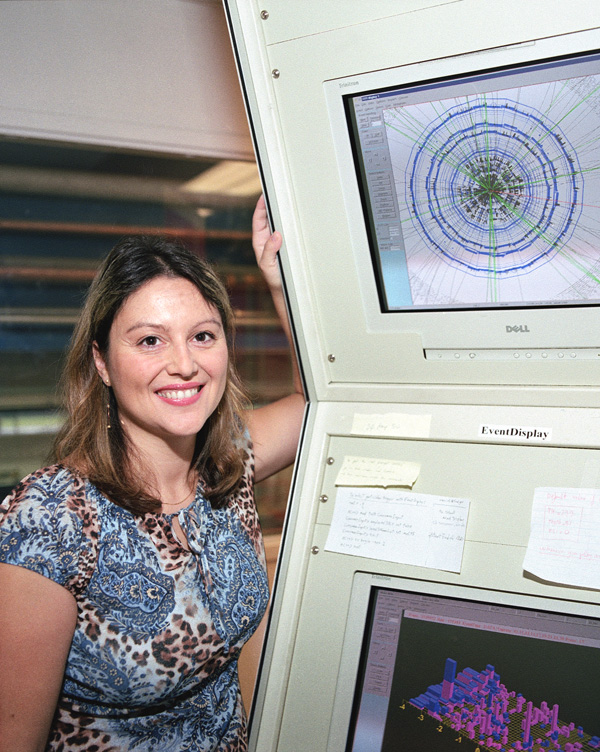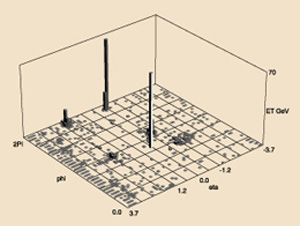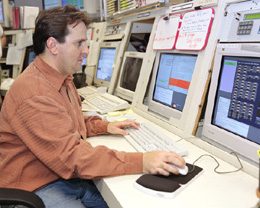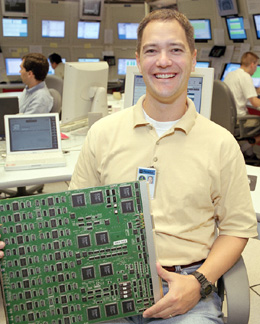 |
|
Particle Detectives Announce First Results by Kurt Riesselmann
Finding a particular person in a sold-out stadium can be a daunting task.
You scan thousands and thousands of faces,many looking similar from
far away.
You might be looking for someone with dark hair – but are you sure your
friend isn’t wearing a hat today? If you remember the color of your friend’s
favorite jacket, your task may be easier. But what if he wears a different coat
for a change? Or even worse, have you considered the possibility that he
hasn’t yet arrived at the stadium?
Particle physicists face pretty much the same dilemma as they look for their
favorite particle friends, such as the top quark and the Higgs boson.They’ve
studied their characteristic appearances and know what these friends “look ”
like, but don’t know when a particular particle will appear and which jacket —
decay mode, in expert’s terminology — it will favor at that moment.
The only chance to spot a rare particle friend is to frequently create large
crowds of particles and take pictures of them. Scientists can analyze such
pictures and identify unique signatures — the particle faces, in the crowd.
That’s exactly what scientists at Fermilab have been doing since the
beginning of Collider Run II in March 2001. Having tuned up their two
“cameras", CDF and DZero, systems of particle-detecting devices that are
as big as three-story houses,they have begun to take more than one million
pictures of particle crowds per second. Although scientists have stored only
the most promising pictures, about 100 per second, they are filling up their
electronic storage space at a rate of one CD-Rom every few minutes.
“To me, it’s like the work of a detective,” said Italian INFN physicist Patrizia
Azzi, who leads the top quark physics group of the CDF collaboration at
Fermilab, together with Pierre Savard from University of Toronto.“It ’s never
the same.”
TOP IN AMSTERDAM
“At the ICHEP physics conference in Amsterdam,
our collaboration showed the first top quark
candidates of Run II,”said Azzi, who worked
as a graduate student on Run I.“Run I saw the
discovery of the top quark in 1995. For Run II,we
are now in the position of doing precision top quark
physics. Our goal is to measure the top quark
mass with a precision of about two percent."
More than 800 particle physicists from across the
world attended the International Conference on
High Energy Physics. About 20 CDF and DZero
scientists had the opportunity to give talks on a
variety of physics topics, highlighting the progress
that Run II presents compared to Run I.
“About eight years ago,we embarked upon a very
aggressive program for the detector upgrades,”
said Kevin Pitts, assistant professor at the
University of Illinois at Urbana-Champaign.
“It seems it will pay off in a big way. We will
measure physics processes that we didn’t have
access to before.”
In Run I,which took place from 1992 to 1996,the
CDF and DZero collaborations each sifted through
more than 100 inverse picobarns (pb
To create top quarks and other particles, Fermilab
scientists create powerful collisions of protons and
antiprotons at the center of the CDF and DZero
detectors. Each collision produces hundreds of
particles in new combinations and geometries,
which the detectors record.
Looking for a specific particle created in these
collisions is challenging. Scientists expect to spot
a particle like the top quark, which is 175 times
heavier than a proton, only in a small number of
“pictures.” During Run I, scientists observed a few
hundred collisions that produced top quarks. For
Run II, however, they expect to find thousands.
ZOOMING IN ON THE HIGGS
Although the current number of Run II “pictures ”is
still smaller than the sample accumulated during
Run I, the quality of the data is much better.
“Because of the higher energy, we have a thirty-five
percent higher production rate for the top,” said
physicist Boaz Klima, who coordinates the physics
analyses of the DZero collaboration.“In addition,
our upgraded detectors are better than during
Run I. Hence every recorded picobarn of Run II
data is much more valuable than the same amount
of Run I data. By spring 2003, we expect to have
the first results for top cross section and top mass
measurement of Run II.”
Improving the experimental knowledge of the
masses of the W particle and the top quark will
help scientists zoom in on a particle that nobody
has ever seen:the Higgs boson. Named after a
theoretical model proposed by Scottish professor
Peter Higgs and others, the Higgs particle is the
missing ingredient in an otherwise successful
model of particles and their interactions.Over
several years, the Fermilab mass measurements
will slowly narrow the window on the Higgs.If the
particle is not too heavy,the Fermilab accelerators
will be able to produce it.
“To directly see the Higgs, it will take time and
data,” said Klima.“You are not going to jump from
nothing directly to discovery. There is still a lot of
work ahead of us.”
LOOKING FOR RARE B’S
“The world expects us to measure Bs oscillations,”
said Pitts, who worked on a new detection
subsystem for bottom quarks.“Our findings will
be complementary to results from the B factories.”
During Run II,the Fermilab accelerators will
routinely produce tens of millions of B mesons
per day. In addition to identifying Bs particles in
this large crowd, scientists expect to catch an
occasional glimpse of bottom quarks wearing
“jackets” never seen before.
“We know that rare decay modes of the B mesons
should exist,” said Pitts.“The question is: how do
you isolate them?”
Pitts and Marjorie Shapiro, professor at
UC Berkeley, head the B physics group of the
CDF collaboration. They coordinate the work of
about one hundred scientists that scrutinize the
CDF data for information on bottom quarks.
“Our upgraded detector is a brand-new tool,”
Pitts said about the CDF experiment.“We now
have new ways of finding things. In addition to
finding B mesons, we get a lot of charm quark
states. In a few weeks of running we’ve got
50,000 decays of a D0 meson into a kaon and
a pion. We’ve also reconstructed D+ and Ds+ charm
states in quantities that have already far surpassed
the Run I samples.”
GODPARENTS MAKE THE CALL
But the new Run II data may hold more treasures.
Scientists are searching for phenomena in
particle signatures and interactions that cannot
be explained by the standard particle theory.
From extra dimensions to leptoquarks to super-
symmetric partners, physicists are prepared for
the unexpected. At Amsterdam, scientists reported
on their search strategies.
“Traditionally, scientists begin to look for new
particles by identifying collisions that have
produced a particle with large momentum
perpendicular to the direction of the incoming
proton beam,” explained Fermilab physicist Gustaaf
Brooijmans, who heads the new phenomena group
at DZero together with Greg Landsberg of Brown
University. “It’s a rather clean signal.
“To look for leptoquarks, for example, the rule of
thumb is: Every time you double the number of
collisions in your analysis, you gain 20 GeV in
your exclusion limits. Improving our analysis,this
winter we could get a limit of 200 GeV — very close
to the Run I results.”
Next year, the particle detectives at CDF and
DZero will be staking out new territory. Whether
they will find any exotic signals remains to be seen.
If they do, they will have pictures to prove it.
On the Web:
|



